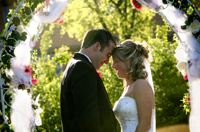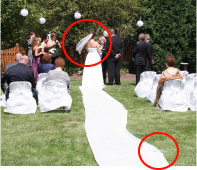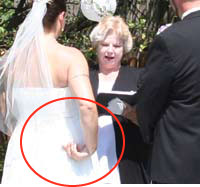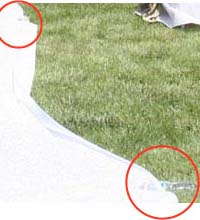
|

|
|
When we think of outdoor weddings,
we think of the romance of crystal blue skies, a light breeze softly
stirring the flowers, and a golden sun shining brightly on the happy
couple…..
<sound of screeching brakes> Come
on, we’re here in the Midwest – the reality is that we
may have five days in the early summer and maybe 10 days in late
summer/early fall when those idyllic conditions may exist. And who
knows when that window of opportunity might happen?
What is far more common is that we will have miserably
cold, wet spring weather right up until early June… when it
turns hot, humid, and sticky and we’re all sprinting for the
A/C! This typically doesn’t let up until early fall… which
most likely brings a return of the cold, raw weather we experienced
in the spring with the occasional taste of a bright, warm day.
And in true Chicagoland style, the weather at any
point in time can be unpredictable! (There’s a lot of truth
to the expression, “If you don’t like the weather here,
wait 15 minutes and it will change!”) There’s nothing
like having to watch the skies as a summer thunderstorm rumbles in
and threatens to wash out your beautifully planned garden wedding! Will
it hold off until after the ceremony? Do we opt now for Plan B? Do
we want to risk having to run for it in the middle of the ceremony? And
heaven forbid that severe weather with its threat of tornadoes should
strike on your wedding day!
Who needs that kind of stress? |
 |
Case in point: I officiated one
summer at a ceremony held in the backyard garden of the groom’s
parents. It was a lovely setting: there were white paper lanterns
hanging from the stand of trees that set a backdrop for the ceremony.
White folding chairs were adorned in white seat covers tied with
bows of tulle and set in rows flanking the grassy aisle marked by
a white runner. A large arrangement of flowers brought the bridal
colors of white and plum to a white wrought iron bistro set nearby.
The perfect scenario for an outdoor wedding, right?
Here’s the reality:
The weather was hot and very humid – the heat
index was mid-90’s. The sun was nearly directly overhead at
the time of the 2 PM ceremony, brutally hot, and there wasn’t
an ounce of shade.
The forecast was for scattered thunderstorms, and
although the sky was blue overhead, to the northwest was a line of
large, black, ominous-looking thunderclouds that were closing fast,
and the breeze was picking up with the looming gust front.
So then the questions started: Will the rain
hold off? Should we just go ahead and move the ceremony indoors?
Are Grandma and Grandpa okay sitting out there in the sun? Then
the aisle runner started to blow, so it was staked at each end
and held in place along each edge by bottles of water (which the
bride’s children had to hop over later as they escorted the
bride down the aisle).
We took a chance and started the ceremony outside.
In their suits and ties, the groom and best man were sweating bullets
as the sun beat down on their dark jackets, and the maid of honor’s
long plum gown was sticking to her with the heat and humidity. The
bride’s veil kept blowing in her face, and I couldn’t
tell if the droplets of moisture on her face were tears of joy or
beads of perspiration!
I’m happy to report that the rain held off
long enough to complete the ceremony, but as soon as it was over,
everybody bolted back into the house and the comfort of the air-conditioning.
Bottom line:if you’re thinking about
an outdoor wedding, reconsider. |



|
However, if you really
have your heart set on one, remember – that
lovely park or garden may be perfectly comfortable back in September
on the day you booked the site, but what will it be like in the middle
of summer on one of our typical Midwest summer days?
Be practical and make provisions for the realities
of our local spring, summer, and fall weather conditions, such as:
- Think of your wedding party, dressed in
their bridal attire. For a summer wedding, tuxes are heavy and
involve multiple layers, and their collars and ties are constricting.
Bridesmaids gowns are usually made of fabric that doesn’t
breathe. Couple that with pantyhose, and you’ve got an
uncomfortable attendant. Even with a strapless dress and flipflops,
those dresses can be hot, and sweat stains aren’t
pretty! As a bride, you’ll be dressed similarly – you’ll
enjoy your wedding much more if you’re physically comfortable,
too.
Consider tux trousers with vests and no jacket, or something even more casual,
for your groom and groomsmen. See if you can find bridesmaid and bridal attire
made of light, natural fabrics that breathe (silk, linen, cotton).
It’s also hard to see in the bright sun without sunglasses – you
don’t want all your photos to be full of squinting people! Provide
some shade for your wedding party (a gazebo, chuppa, or other shade structure).
Your officiant will thank you, too.
With a fall wedding, strapless
gowns could leave your attendants trembling with the chill instead of with
excitement for your happiness. Since pretty much anything goes weather-wise
in either the spring or fall, choose a dress style with a separate bolero,
shrug, or wrap, so they are prepared for any eventuality.
.
- Think of your guests. They’re all dressed up in suits and ties,
or dresses and pantyhose, too. They will be sitting out in whatever weather
you’re having that day for up to a half-hour before your ceremony,
and then through the ceremony itself. Baking out in the hot sun, or shivering
in the cold and damp, is mighty uncomfortable, especially for those who are
very young, elderly, or have health issues. Consider providing a tent for
your guests to sit under, with overhead fans if it’s hot, or standing
patio heaters if it’s chilly. Be sure the tent comes with sides,
so that you can protect your guests from rain or wind, if needed. Or
perhaps you can find a venue with a roofed outdoor pavilion, instead.
.
- And then there are the bugs. Muggy summer days bring out the gnats, no-see-ums,
and mosquitoes. September is the season for bees and wasps. You and your
groom will not be the center of attention if your guests are busy swatting
at annoying, dive-bombing bugs.
.
- Make some other practical choices, too:
.
- Wear a short veil,
or just a headpiece, that won’t
blow in your face by the wind. Tie your hair back or wear
it up, for the same reason.
.
- Choose the Blending
of Sands rather than the Unity candle ritual so that you
won’t have to fight to keep your candles lit in any breeze
you might be having. A candle that won’t stay lit spoils the moment,
and a lit candle that blows over and starts a fire is the type of excitement
I’m sure you want to avoid.
.
- Best advice for an
outdoor ceremony: skip the aisle runner altogether. Use rose
petals to mark your “aisle” rather
than a runner that will blow, especially if the venue surface
is on turf. Rose petals tend to nestle into the blades of
grass or cling to a rough surface and stay put better. Also
bear in mind that aisle runners are meant for hard-surface
floors or very low-pile carpet, and can be tricky (possibly
even dangerous!) to navigate when you add high heels and
soft grass to the mix.
.
Also, even if the venue surface is concrete or pavers,
you can’t
stake a runner in place on those surfaces, so it will tend to twist, fold
over, and become askew in any breeze. You don’t want to get caught
up in the runner and fall as you walk down the aisle – while that
might be a dramatic entrance, I’m sure it’s not
the kind you have in mind!
.
- Whatever decorations
you choose for your outdoor ceremony, make sure they can
stand up to a good wind. I’ve seen
arches fall (and hit the bride!) and flower arrangements
tumble when the wind picked up.
.
- Be sure that the ceremony
location is treated for insects far enough in advance that
you’re not choking on bug
spray, but close enough to the time of the ceremony to still
be effective.
.
Holding your wedding
ceremony outdoors can end up being a miserable experience full
of discomfort and stress for all concerned. However, if you
make the right choices, an outdoor wedding can be a charming
and romantic way to start your married life together.
|
|






